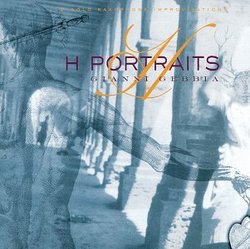| All Artists: Gianni Gebbia Title: H Portraits Members Wishing: 0 Total Copies: 0 Label: Rastascan Records Release Date: 8/17/1998 Genres: Jazz, Pop Style: Avant Garde & Free Jazz Number of Discs: 1 SwapaCD Credits: 1 UPC: 759237003727 |
Search - Gianni Gebbia :: H Portraits
 | Gianni Gebbia H Portraits Genres: Jazz, Pop
|
Larger Image |
CD Details |
CD ReviewsGreat solo sax. greg taylor | Portland, Oregon United States | 07/10/2004 (5 out of 5 stars) "Extended technique for the saxophone has been heavily developed over the last forty years or so. Players can use false fingerings and embouchure variations to create multiphonics (the simultaneous sounding of several notes creating a chord or arpeggio effect). Embouchure can be varied in the attack of the note to create articulation effects. False fingerings can be used to extend the upper range of the horn. You can approach the instrument not as a musical instrument but as metal, cork and reed that can be used to generate myriad sound effects. Or, you can use circular breathing (the simultaneous drawing in and blowing out of the breath to create amazingly long lines without pause). For more info on these techniques, take a look at Jay C. Easton's site.
The solo saxophone recital is the best place to appreciate how all of these extended techniques can be put to musical use. Gianni Gebbia is obviously influenced by two of the main practioners of the solo sax, Anthony Braxton and Evan Parker. But he is also influenced by many others- Julius Hemphill, Ornette Coleman and Lee Konitz among others. The pieces on this CD are dedicated to people who Gebbia admires whose names begin with the letter "H". Helmholtz, Hiroshige, Hemphill, Huygens and Heisenberg among others make for a strange brew. But since this group seems to have inspired Gebbia, I am going with it. Gebbia largely uses a variation of a technique of Parker's. Evan Parker uses his ability to do circular breathing and to rapidly articulate individual notes to create streams of sound that feature repetitive patterns with slight variations that morph the pattern into something else. When Parker has a head of steam up, he begins to create polyphonic melodic variation. I call this the Demented Bach approach. Gebbia follows suit but stays with one melodic arc. He also happens to be a more lyrical player than Parker so this ends up being a case where less may be more. Since Gebbia like Parker (and really, like Sonny Rollins before them) seems to be endlessly inventive the result can be a trance like state of listening. Delightful melodic motifs appear both out of nowhere and organically from what came before. I have talked about this before in some of my reviews. One of the delights of great art is a unfolding logic that is both a surprise and yet is inevitable. (I hope that makes sense.) Gebbia has this quality in abundance. He also makes use of most of the other extended techniques that I mentioned without making a theory of improvisation out of them. This is a modernist sax player who is really worth knowing about and listening to. I actually think that this is one of his better CDs to use as an introduction to what he is about. I also recommend People in Motion (a trio) for that purpose. And if you ever get a chance to see him live do so. He does not disappoint." |

 Track Listings (12) - Disc #1
Track Listings (12) - Disc #1